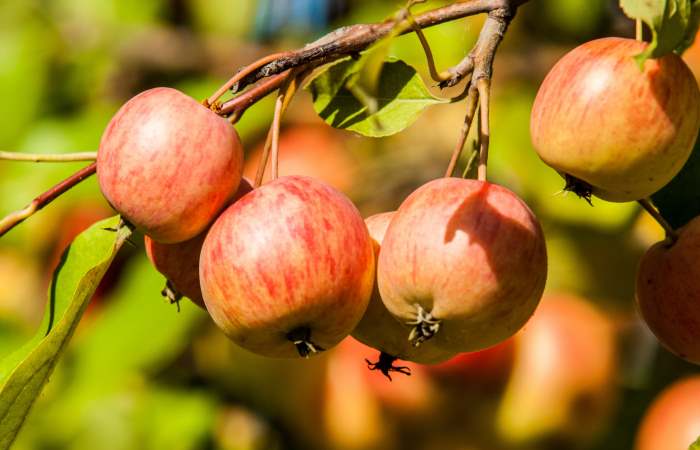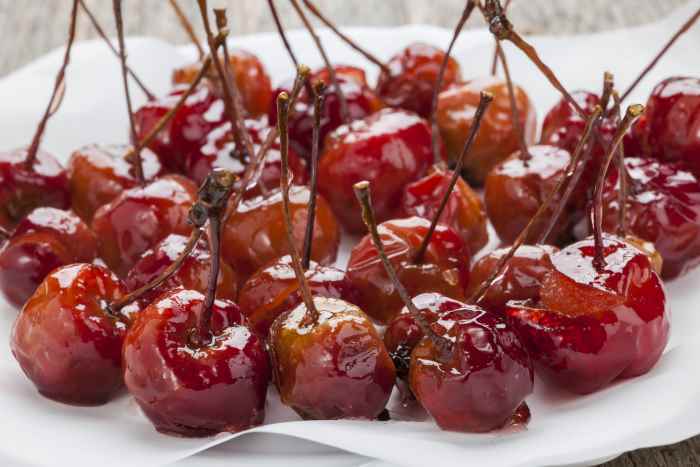Crabapple trees are a beautiful ornamental addition to your landscape, but many people wonder if crab apple fruit is poisonous.
With nearly one thousand different varieties of crab apple trees, knowing the answer to whether or not the crab apples on a specific variety are edible can take some research.

Luckily, I put together this guide so you can quickly learn if crab apples are edible, what types there are, and answer frequently asked questions including whether or not crab apples are safe for dogs to eat.
So read along as I give you pertinent details about crab apples and the trees they grow on, so you can add the right variety into your home’s landscaping.
Are Crab Apples Edible?
As a general rule, the flesh of the crab apple fruit is edible.
Crabapple trees are a close relation to apple trees, but the fruit is much smaller.
Some crabapple varieties will have a sweeter taste and work better for making jams or desserts. The fruit size and color also varies between tree varieties.
Flavor
Crabapple flavor is always tart, with some fruit varieties so extremely tart most people consider them inedible.
While standard apples can be eaten raw, people unanimously cook crab apples with lots of sugar to offset the tart or bitter flavor and bring out the apple essence.
Jelly, pies, pickles, and chutney recipes are easy to find online that use crabapples as the main ingredient.

If you have an abundant crabapple crop growing in your tree (or a neighbors yard), don’t let them go to waste. Give crab apple recipes a try!
Types Of Crab Apples
There are two types of crab apples, edible or ornamental.
While crabapple trees can produce a wide array of colors, sizes, textures, and flavors of fruit, the type of crab apple is determined by if you should eat it or not.
Edible Crabapple Type
Some crab apple fruits have a flavor worthy of making them into edible treats.
The top varieties of crabapple trees with edible fruit are:
- Centennial crab apple
- Chestnut crab apple
- Dolgo/Dalgo crab apple
- Pink Spires crab apple
- Hopa crab apple
- Red Vein crab apple
So if you are looking for a crabapple tree with delicious edible fruit to make preserves or desserts, consider planting or buying any of the above varieties.
Be specific when asking about crabapple tree fruit. Technically, all crab apples are edible, which could leave you with a bad taste in your mouth after spending money and effort to plant a tree.
You need to ask about sweetness, flesh texture, and flavor notes if you plan to cook up your crabapple crop.
If the seller can’t answer these questions, do a quick search of the specific variety online to ensure you purchase fruit that is tasty to cook.
Ornamental Crab Apple Type
The second type of crab apple is ornamental. The tree can be of average height, while many are dwarf, which makes it easier to incorporate into a homeowner’s landscape design.
The fruit tends to be very small, with a hard texture and high tannin levels. The taste will be painfully tart or bitter, rendering the fruit useless for cooking up jams or jellies.
While the fruit of these trees is not worthy of eating, they are quite stunning in color and shape.
After enjoying the abundant blooms of flowers that cover the crab apple tree in the late spring, you get the pleasure of several more weeks of color as the fruit matures.
The top varieties of ornamental crabapple trees are:
- Malus or “Camelot” crab apple
- Firebird crab apple
- Royal Raindrops crab apple
- Sparkling Sprite crab apple
- Red Jewel crab apple
- Sargent Tina dwarf crab apple
There are a few crabapple trees bred to produce no fruit at all like “Prairie Rose” and “Spring Snow.” But, most ornamental trees produce fruit that remains on the tree much longer before falling off than sweet varieties.
If you have pets, especially dogs, you need to be aware of the potential issues crab apples could cause.
Learn about this and more in the next section, where I answer common questions about crab apples.
Frequently Asked Questions
Can Dogs Eat Crab Apples?
Dogs should never ingest crab apples! Here’s why:
Because, just like a full-size apple, crab apple stems, seeds, and leaves contain the chemical cyanogenic glycoside. This chemical is better known as cyanide, which is poisonous to dogs of any age.
The flesh of the fruit is not dangerous, but what dog do you know that will peel, deseed, and core a crabapple they find on the ground?
Common signs of crab apple poisoning include:
- Panting
- Dilated pupils
- Red lips, gums, or tongue
- Diarrhea
- Vomiting
- A decrease in heart rate and oxygen levels
- Seizures
- Coma
- Death
Levels of this toxin are highest in the leaves and fruit during autumn, so be especially diligent in raking up such fallen debris if the crab apple tree is in a location your dog can access.
Do Deer Eat Crab Apples?
Deer sure do like to eat crabapples and show no signs of negative reactions to eating the fruit.
Deer are picky eaters and will favor juicier, sweeter variations and save the less desirable types of crabapple fruit until other food sources run low.
For this reason, you can encourage wildlife like deer to visit your yard if you plant a couple of different varieties of crab apples.
Sweet-fruiting varieties will provide food for the deer to eat early in the season, while more bitter-fruit types will bring them back later on when other food is scarce.
What Do Crab Apples Look Like?
Crabapples look like mini apples, with the size being the distinction between the two.
They are both members of the Malus apple genus. When the fruit of this genus is under two inches in diameter at maturity, it is a crab apple. Above that dimension, the fruit is a standard apple.
Crab apples can be as small as 1/4-inch in diameter, on up to two inches in size. Some fruit may have an elongated shape, somewhat like a plum.
Colors of crabapple fruit can range from bright red, yellow, orange-red, crimson, yellow-green, and reddish-purple. The outer skin can appear shiny or have a dull or “dusty” look.
What Does A Crabapple Tree Look Like?
It is a bit difficult to describe a crabapple tree since each variety will reach a different height and spread, display a unique bloom color, and produce different sizes of fruit and leaf. Trunk colors may vary.
As an overview, I can narrow down general traits all crabapple trees have.
Height
Crabapples top out at 30 feet, but most fall in the 15 to 20-foot range, which makes them perfect for yards for both privacy and to not interfere with power lines. Dwarf varieties grow up to eight-foot-tall and make a beautiful focal point in your landscape.
Foliage
Leaves come to a point and have serrated edges. The color begins as light green in the spring and darkens over months. As the weather cools, the leaves turn yellow/orange or red/purple depending on the variety.
The leaves (and fruit) grow in clusters. The leaves form an off-set pattern down the branch instead of directly across from each other.
Blooms
Flowers form in dense bunches in shades of white, light to dark pink or purple.
Fruit
The fruit hangs from the tree on long stems, looking more like a cherry than an apple. The size is under two inches in diameter.
Trunk and branches
Crabapple trees develop thin trunks and frequently are many-trunked as they stretch up into wide, dense branches that give the tree a round shape.
The color and texture of the outer bark become mottled as the tree matures.
In Summary
While crab apples are poisonous to dogs when eaten whole, humans can indulge in this tart fruit by preparing and cooking it correctly.
Crab apples make delicious jams, kinds of butter, and other treats when you select the sweetest varieties.
Crabapples not only attract birds and other wildlife drawn to the nutritious fruit it provides.
The bright, color-changing foliage and stunning clusters of blooms add tremendous visual appeal to your landscape during all seasons of the year.
I hope this crabapple guide inspires you to try crabapple recipes and maybe plant a variety or two of crab apple trees in your yard!










